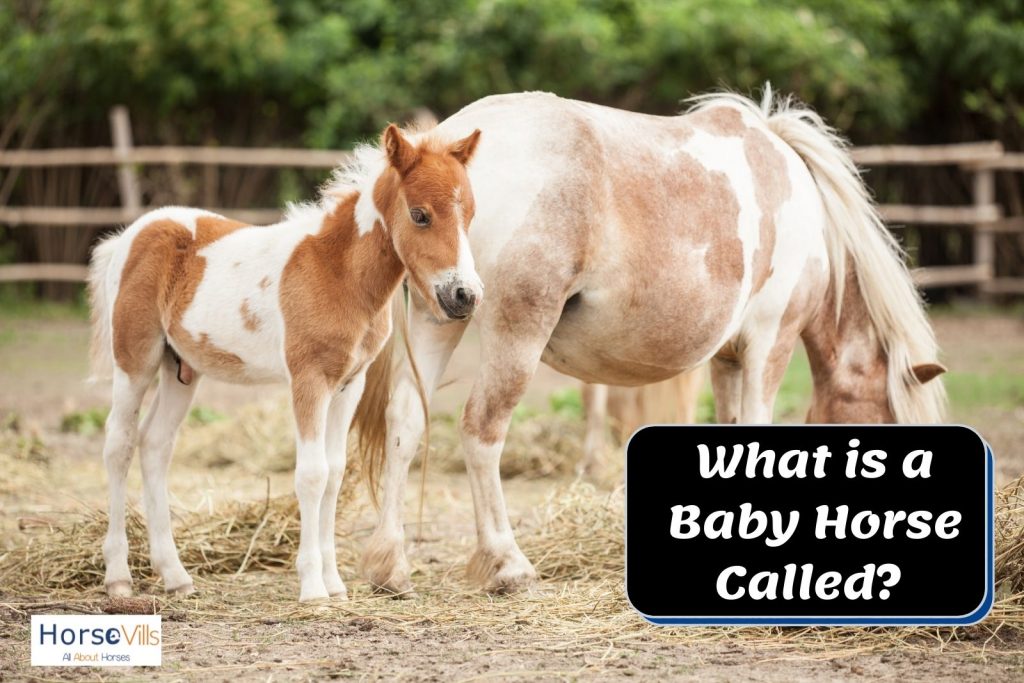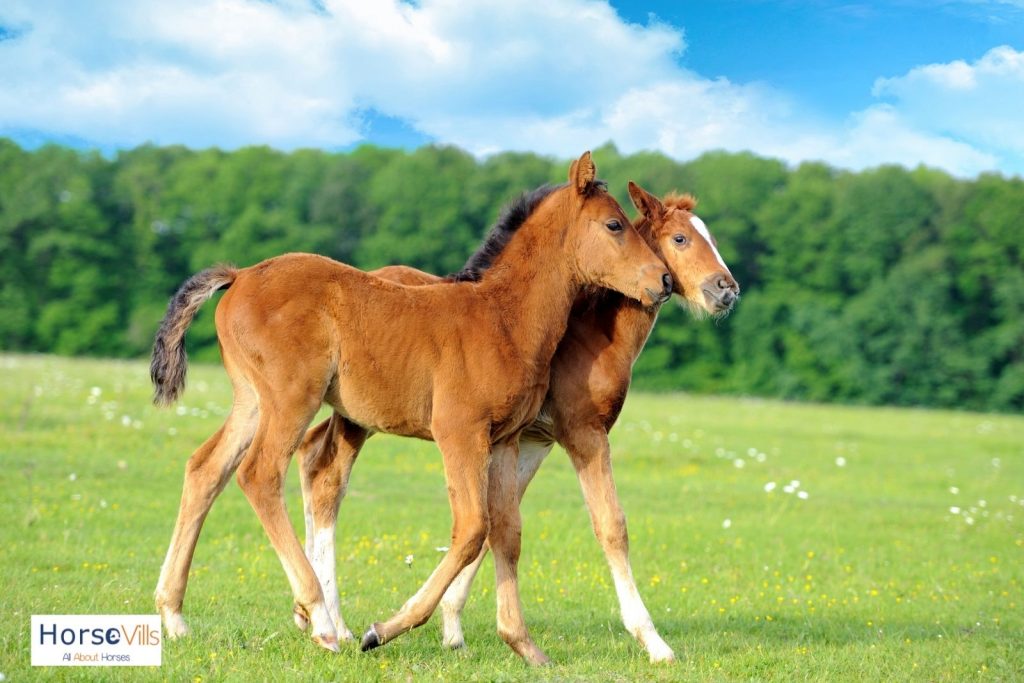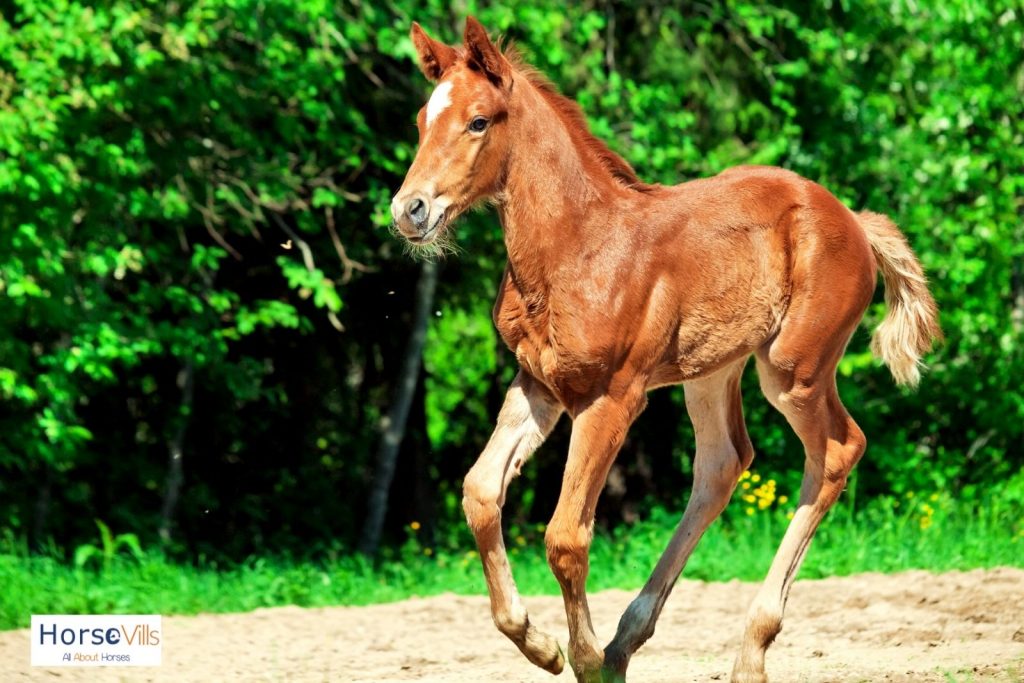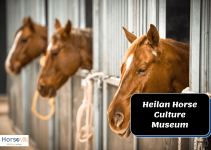If you want to know what is a baby horse called, I’ve got the answers…but it’s not as straightforward as you might think!
Of course, you can still call a baby horse just that, but in the equestrian community, that term is not used.
I am here to help you learn all the lingo, which is pretty confusing if you haven’t heard it before, plus a ton of other great info about young horses.
Let’s jump in and know what a baby horse is called and get started!
READ MORE: How Many Different Breeds of Horses Are There?
Table of Contents
What is a Baby Horse Called?
All baby horses are called foals. This applies to the young horse until it is six months old, but some people might use it until it reaches the age of one.
That is the easy part, and if you remember that, you’re doing great. However, equestrians also used other terms more specific to the gender of the foal.
We will tackle those next. This is where it gets confusing if you’re new to horses.

What is a Baby Female Horse Called?
First, let’s get to the girls. A female baby horse comes with its own name.
All female foals are called fillies, or filly, or sometimes even filly foals. The same time periods apply here as you saw with the colts.

So, when you hear the word filly, it can mean the horse is anywhere from 1 day old to just under the age of four. What doesn’t come into play here is a separate term like a gelding, as female horses are not spayed.
When a filly reaches the age of four, she then becomes a mare. This is the equivalent of an older human teenager.
They are pretty much adults. Every female adult horse is called a mare. There is an extra term that can apply when a mare is used specifically for breeding. This type of horse is a broodmare.
READ MORE: Breeds of Beautiful White Horses
What is a Baby Male Horse Called?
Colt or colt foal is the term used for male baby horses only. However, this term stays with the male foal longer than its first six months.
If you hear someone calling a horse a colt, that horse could be 3 months, 1 -year, or even 3 years old.

All male horses, up until they reach their fourth birthday are called colts. Now, this is where things get a little tricky, as there are two other names for male horses.
If you’re looking for cute and charming names for your foal, this video is a great place to start, filled with a range of adorable and creative options to choose from:
Is Gelding a Male Horse?
Only male horses can be called geldings. But the term is specific to certain kinds of males. When a male horse is castrated, it is referred to as a gelding. This usually doesn’t happen until a foal is at least 6 months old.
Therefore, if you hear the term gelding, you can safely assume that the horse is over 6 months of age. Once gelded, the term stays with the horse regardless of its age, but there is another term that can apply, which we’ll get to in a bit.
When is a Horse A Stallion?
A stallion is a male adult horse that is not castrated. When a male horse turns 4, it is no longer called a colt, and instead, the term stallion is used.
Another term you might hear when someone is referring to an uncastrated male horse is a stud.
Now that you know everything there is to know about what to call a baby horse, let’s go over some other topics that will come up in the same conversations.
READ MORE: What Do You Call a Group of Horses?
Looking for cute and memorable names for your new foal? Check out our “baby horse names” video for inspiration:
When Can You Wean a Baby Horse?
Most people wean a baby horse when it is six months old. At this age, the foal does not need milk to survive. They are eating grass, hay, and grain at this stage.

Some breeders prefer to leave the foal with its mother for longer, either until the mare weans it naturally or until it is 1 year old. This is because they feel the foal is not mentally mature enough to be without its mother yet.
In the wild, a foal stays nursing from its mother until it turns one, usually when the mare gives birth to her new foal.
Can You Breed a Young Horse?
It is possible to breed a young horse from the age of two for a foal when they turn three. However, this is not advisable and good breeders do not follow this practice.
At two or three the young horse is not physically or mentally mature enough to go through pregnancy and rear a foal.
Foaling is a risk for any mare, but breeding her too young can greatly increase this, potentially putting the foal and dam in danger. It is best to wait until your mare is at least three, preferably four to breed it for a foal the following year.
3 Common Problems in Baby Horses
A newborn horse needs special and knowledgeable care. An unwell foal can go downhill very quickly. Here are some common problems every horse breeder needs to be aware of.
#1 Failure of Passive Transfer
Failure of passive transfer is one of the most common problems in baby horses, and one of the most serious. A foal is born with no immunity and it takes a few weeks for its immune system to start working.
The first milk a mare produces is called colostrum. This thick, sticky milk contains essential for the foal, which is absorbed through the intestines. There is only a short few, 6-12 hours, after birth when the foal can absorb this.
If the foal does not get any or enough colostrum in time, it can get seriously ill very quickly and it is often life-threatening.
Several factors can cause this, even in healthy foals. Complication at birth is one of the common causes of passive transfer failure.
See a sample video below:
#2 Neonatal Sepsis
Neonatal sepsis occurs when bacteria enter the foal’s body, often via the still-healing umbilical cord break under the stomach. Baby horses that do not get enough colostrum are at very high risk of this.
It is the most common cause of death in foals that are less than two weeks old.
#3 Meconium Impactions
Meconium impaction, while serious has a much better prognosis than the other two foal problems mentioned above. The first feces of a foal is called the meconium, which should pass within a few hours of birth.
Foals that look like they are straining poop and show signs of pain and distress are often suffering from this. This condition needs immediate attention but usually resolves with an enema.
READ MORE: Do Horses Mate With Their Offspring?
Tips for Taking Care of Baby Horses
Baby horses, just like human babies need looks of extra care and attention to help them thrive and stay healthy. Here are some tips to help you understand what’s involved.
- For the first few days after birth, dip the umbilical stump in iodine to help prevent infection
- The day after a baby horse is born get an equine vet to come and give it an exam. The vet will help you know if there are problems with the legs, such as lax tendons, and should always do an IgG test to make sure the foal got enough colostrum.
- For the first few weeks of life, keep the foal’s environment clean and avoid too much exposure to new horses. This helps avoid risks of infection.
- Ensure you have a safe pasture area for your foal. It should be free from hazards and have the right type of fencing. Avoid fences where the foal can get its leg stuck.
CHECK: Beautiful Clydesdale Horse Breed
What Are Young Horses Called?
In addition to foal, filly, colt, mare, and stallion, you will hear some other names that apply to horses of certain ages. For example, yearling filly.

When a horse is weaned from its mother it becomes a weanling. In a domestic environment, most foals are weaned at six months of age.
Weanling applies to all baby horses, male or female, from the age of six months until they turn one.
Of course, you might still hear someone use the word foal for this age. In a wild environment, a foal will continue nursing from its mother for longer than six months.
When a horse turns one, it becomes a yearling. Fillies, colts, and geldings are all also yearlings if they are between the ages of one and two.
The yearling stage of life for horses is the period when they look the gawkiest, as their body is doing a lot of growing.
Once a horse turns two, there is no special name for this age. The young horse, still very much a baby, similar to a toddler, is now a filly, colt, or gelding.
Interesting Facts About Baby Horses
Foals are pretty amazing creatures. Even though horses have been domesticated for thousands of years, they still retain some of their wild traits.
In a wild situation, a horse, since it is a prey animal, lives in a herd for companionship and protection.
Giving birth is one of the most vulnerable times for a female horse. Foaling for horses has to be a relatively quick process for the foal’s, mare’s, and herd’s safety.
One of these ingrained safety measures is to give birth at night. Darkness provides cover from predators. It is also a quieter time, and many mares prefer this to have their foal.
Despite this, if you have a pregnant mare, you should never leave her to foal on her own.
The best course of action is to prepare yourself with knowledge and supplies. Then watch your mare have her baby from a quiet, safe distance, but be one hand if you need to intervene.
Foal Slippers
One of the most amazing facts about baby horses is the slippers. When a baby horse is born, its hooves have soft, finger-like tissue attached to them.
These slippers protect the dam’s (mother’s) womb and the birth canal from damage that the hard hooves can cause.
You have to be quick to see these slippers. As soon as they make contact with the air, they begin to disintegrate. By 24 hours after birth, the slippers are completely gone and all you can see are normal hooves.
When Does a Foal First Stand
Due to their vulnerability, in a wild environment, a foal must stand quickly. This trait still applies to all horses, even if born in a stable.
Within five minutes of birth, the foal should be able to lay with its head up in a sternal position.
By one hour, the foal should be trying to stand. Some take up to two hours, which is ok, but longer than this will need intervention. It is important that the foal can stand as quickly as possible.
As soon as the foal is standing, it needs to be a nurse. The first milk, which is called colostrum, is absolutely essential.
A foal is born with zero immunity. Colostrum contains the necessary immunity the foal needs to survive its first few weeks of life.
The intestines can only absorb these essential nutrients via passive transfer in the first several hours after birth.
This is why it is so important. With a new foal, you should have the vet out to do a test for this immunity that day after it is born.
This will tell you if the foal got enough colostrum. If the score is too low, the vet will need to give the foal a plasma transfusion.
This is immunity is vital, as, without it, the foal can very easily suffer an infection, and any infection in a newborn foal is life-threatening.
Look at this amazing video of a foal taking his first steps:
ALSO CHECK: Prettiest Horse Coats
FAQs
Talking about a baby horse is always fun, they are just so adorable. But we’re sure after reading this, you have a few questions. We’ve answered a couple of them here.
Can you ride a baby horse?
No, you can never ride a baby horse. Their bodies are not mature enough and you can cause serious problems. A baby horse’s back and other body structures cannot support any extra weight. You should not ride a horse until it is at least three years old.
What do you call a mother horse?
A mother horse is called the ‘dam’. But many people will say mother or mom.
Do you wean a foal on its own?
It is always best to wean a foal with other baby horses of the same age. Ideally, you will keep mare and foals together and wean the same group together. This way, the foals have friends, and it makes the process less stressful. Usually, a nanny horse is put with the weanlings to help them learn how to be horses and manners.
How long is a mare pregnant?
The gestation period for a horse is 11 months. The average mare will give birth at 345 days pregnant, but some can carry for even longer. There is no hard and fast rule here, and the mare is partially able to control when she has her baby. To survive birth, the foal needs to be at least 330 days gestation at birth. Earlier than this is premature and a foal born before 300 days is very unlikely to survive.
Is a pony a baby horse?

No, a pony is a type of equine that is no taller than 14.2 hands tall. There are distinctive horse and pony breeds. Foal, filly, and colt all apply to a baby pony.
Do baby horses change color?
All foals are born with a foal coat. This is either a completely different or slightly different shade than their adult coat color. After a few months, the foal will shed its foal coat to reveal its true color.
Conclusion
You are now an expert in all the names used for a baby horse. In fact, you can now distinguish and use the correct term for a horse of any age or gender.
I’ve even included some interesting baby horse facts for you. I hope it helped you on your horse knowledge journey.
References
- “Common Illnesses of Newborn Foals.” 2016. Veterinary Practice News. March 24, 2016. https://www.veterinarypracticenews.com/common-illnesses-of-newborn-foals/.
- “Evaluation & Care of Newborn Foals | AAEP.” 2016. Aaep.org. 2016. https://aaep.org/horsehealth/evaluation-care-newborn-foals.
- Harman, Joyce. 2011. “Appropriate Breeding Age.” Expert Advice on Horse Care and Horse Riding. Expert advice on horse care and horse riding. August 11, 2011. https://www.equisearch.com/articles/appropriate-breeding-age.
- Horse Racing Sense. 2019. “What Is a Baby Horse Called? When Do They Stand and More…” Horse Racing Sense. August 18, 2019. https://horseracingsense.com/what-is-a-baby-horse-called/.
- “Mare Gestation Calculator – the Horse.” 2020. The Horse. November 10, 2020. https://thehorse.com/tools/mare-gestation-calculator/#:~:text=The%20average%20gestation%20length%20in,gestation%20lengths%20outside%20this%20range.
- “Weaning Your Foal | AAEP.” 2016. Aaep.org. 2016. https://aaep.org/horsehealth/weaning-your-foal.

“What is a baby horse called?” Do you have a special name for your baby horse? We’d love to hear it below!
Siun is an all-around animal lover, with a passion for horses. She grew up in the United States, competing in the hunters, equitation, and jumpers. Now living in Ireland, she competes with her own showjumping horses. She is experienced in the care and training of horses, as well as teaching riding lessons. She loves to combine her love for horses with her work. When not working, Siun will be found at the stables, rain or shine.
Find her on FACEBOOK
Read her latest ARTICLES.
Learn more about HER



![The Shire Horse Size Comparison Chart [Comprehensive Guide]](https://horsevills.com/wp-content/uploads/2023/06/Shire-Horse-Size-Comparison-211x150.jpg)